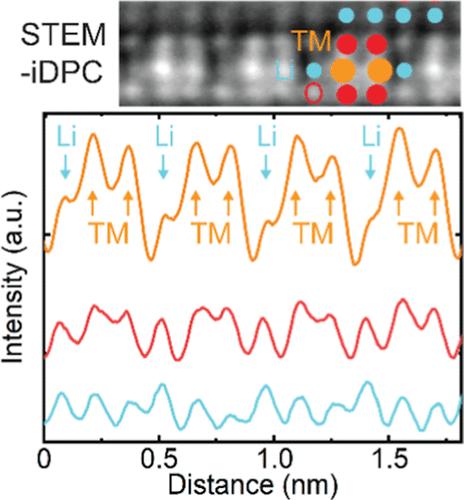富锰锂阴极层错和畴连接的原子结构特征
IF 16
1区 材料科学
Q1 CHEMISTRY, MULTIDISCIPLINARY
引用次数: 0
摘要
富含锂和锰的层状氧化物(LMRs)是一类丰富的可充电锂离子电池阴极材料,结晶成两种不同对称的层状结构:以Li2MnO3为代表的C2/m和以LiMn0.5Ni0.5O2为代表的R3 /m。关于C2/m和R3 /m畴在同一氧化物颗粒中如何在空间上相互关联以及C2/m层错在这种情况下如何排列的基本问题仍然存在。本文利用扫描透射电子显微镜(STEM-iDPC)的集成差相对比成像技术,研究了一种原型无钴LMR材料0.3Li2MnO3·0.7LiMn0.5Ni0.5O2 (Li1.13Mn0.57Ni0.3O2)的结构和成分细节。C2/m和R3 /m结构域之间的连接是突然的,这是由于两种结构之间的小晶格不匹配造成的。C2/m畴的层错具有原子平面移动的特点,可以适应层错顺序的变化,这就解释了为什么层错的形成是随机的。此外,还发现了与C2/m层错相关的局部失序机制。化学上,发现在Li2MnO3畴内的过渡金属位上Ni与Mn共存。这项研究表明,STEM-iDPC是一个非常有用的工具,可以捕获单幅图像中的所有元素,揭示lmr中域连接和堆叠错误的原子细节。本文章由计算机程序翻译,如有差异,请以英文原文为准。

Atomic Structural Features of Stacking Faults and Domain Connections in the Li- and Mn-Rich Cathode
Li- and Mn-rich layered oxides (LMRs), a class of earth-abundant materials for rechargeable Li-ion battery cathodes, crystallize into layered structures of two different symmetries: C2/m represented by Li2MnO3 and R3̅m represented by LiMn0.5Ni0.5O2. Fundamental questions about how the C2/m and R3̅m domains spatially correlate within the same oxide grain and how the C2/m stacking faults arrange themselves when this happens still remain. Here, by using integrated differential phase contrast imaging in scanning transmission electron microscopy (STEM-iDPC), we probe the structural and compositional details of a prototypical, cobalt-free LMR material, 0.3Li2MnO3·0.7LiMn0.5Ni0.5O2 (Li1.13Mn0.57Ni0.3O2). The connection between the C2/m and R3̅m domains is found to be abrupt, facilitated by the small lattice mismatch between the two structures. Stacking faults in the C2/m domains feature atomic plane shifting that accommodates stacking sequence changes, which explains why the stacking faults form in a random manner. Furthermore, a local disordering mechanism was identified to correlate with the C2/m stacking faults. Chemically, it is found that Ni coexists with Mn at the transition metal sites within the nominal Li2MnO3 domain. This study demonstrates that STEM-iDPC is a very useful tool for capturing all the elements in a single image, revealing atomic details on domain connections and stacking faults in the LMRs.
求助全文
通过发布文献求助,成功后即可免费获取论文全文。
去求助
来源期刊

ACS Nano
工程技术-材料科学:综合
CiteScore
26.00
自引率
4.10%
发文量
1627
审稿时长
1.7 months
期刊介绍:
ACS Nano, published monthly, serves as an international forum for comprehensive articles on nanoscience and nanotechnology research at the intersections of chemistry, biology, materials science, physics, and engineering. The journal fosters communication among scientists in these communities, facilitating collaboration, new research opportunities, and advancements through discoveries. ACS Nano covers synthesis, assembly, characterization, theory, and simulation of nanostructures, nanobiotechnology, nanofabrication, methods and tools for nanoscience and nanotechnology, and self- and directed-assembly. Alongside original research articles, it offers thorough reviews, perspectives on cutting-edge research, and discussions envisioning the future of nanoscience and nanotechnology.
 求助内容:
求助内容: 应助结果提醒方式:
应助结果提醒方式:


